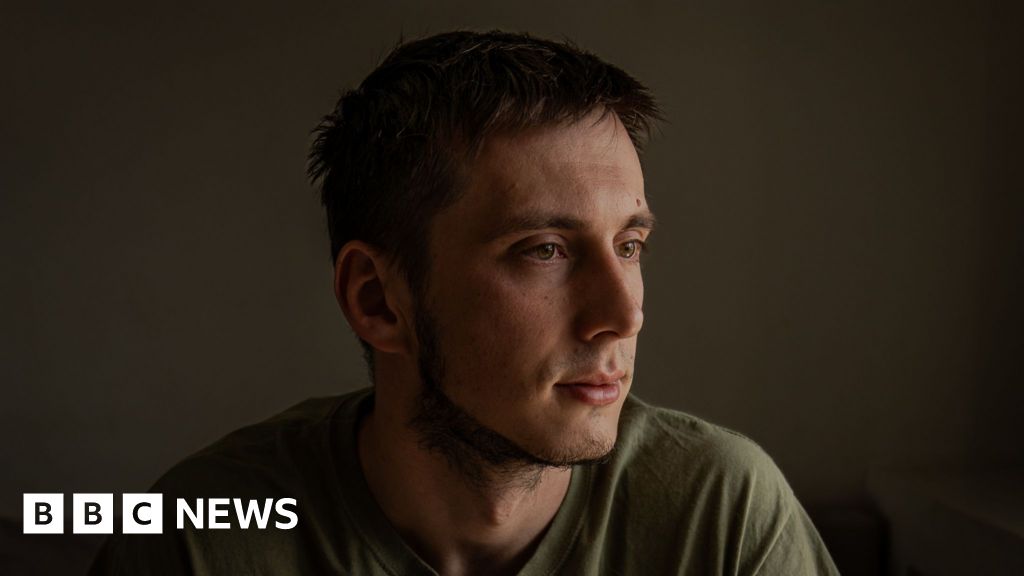Kiev reporting
 Bbc
BbcIn a narrow apartment in the Ukrainian capital Kiev, Pavlo, a 30-year-old drone operator who recently returned to the front, unbuttoned a black case the size of a pizza box. There was a four-road drone inside, which he intended to fly around the room.
He pressed the buttons on the control unit and pressed the antenna in different positions. Nothing happened. “I’m sorry, not today,” he said with a smile. The device looked good, but something was broken.
Paul, who wanted to be identified only by his name, was a first -person drone pilot (FPV). These small, highly maneuvering drones have front cameras that allow them to fly remotely. In the last year, or around this, FPV bombs have become ubiquitous on the front lines in Ukraine, replacing the heavy weapons that characterize the first phase of the war.
FPVS pursue armored vehicles, hunt infantry units through Trelin and lurk individual soldiers for their death. “You can’t hide from FPV and run is useless,” Paul said. “You try to be as calm as possible and pray.”
Even when FPV is too tall to see clearly or hidden behind the greenery, soldiers can hear its distinctive, high whining.
“Bzzzzzzzzz,” Pavlo said. “You are hunting.”
 Ghetto images
Ghetto imagesAfter more than a year on the front, Paul returned home to the apartment in Kiev, which he shared with his wife. But the sound of the drones followed it. Daily mechanical tools such as odds, motorcycles and air conditioners remind him of FPV that hunted him and his teammates.
And nature is not an escape. Paul can no longer hear the sound of bees and flies that buzz near it, without panic. “I don’t like to get into nature anymore and hear that sound because it reminds me so much of the drones,” he said.
The sound -related trauma is not new – generations of soldiers have been affected by sudden noises after returning to civil life. But since the war in Ukraine has become a conflict, driven by drone technology, trauma has developed with it.
“In the last year, the bigger part of the patients – if they are not physically injured – have injuries to mental health as a result of being subjected to drone activity,” says Dr. Sergius Andricenko, Chief Psychiatrist at Kiev Military Hospital. “We call this droonephobia.”
Many thousands of men are now returning from the front as Paul, with acute stress disorders associated with drones, said Dr. Andricenko. Dracnephobia can be triggered by an array of ordinary urban sounds – small motorcycles and scooters, odds, air conditioners – everything mechanical that rotates.
“If this is a moped or mower, my first thought is that it may be a drone,” said another return soldier to the front, soapur, who lost his hand when attacking FPV drones.
On the front line, the drones were a “constant sound”, said Sapur, who in accordance with the military protocol requested to be identified by his appeal. “The sound of the shell only lasts a few seconds, but the sound of the drone is there most of the time,” he said.
“You can lie in your position, in your fox and listen to it for hours. I remember that sound all the time.”
Or sometimes the problem was the opposite – silence. “Silence is always the beginning,” said Dr. Andricenko, the psychiatrist. “When soldiers continue to rotate to fight positions, they begin to listen carefully to make sure there are no drones. There is constant tension, constant fear. They always look.”

In many cases, this constant sense of tension was not distracted by the return to civil life. The observed soldiers suddenly exclude lights at home, move away from the windows and hide under furniture.
Later, if you can see a treatment soldier, Dr. Andricenko describes how often there is no memory of any trigger sound, but his wife or family member will reveal that the fan or air conditioner of an extractor has just been turned on.
Soldiers from the higher phases of war – which were characterized more by a brutal, direct battle – they came home, afraid of being in forests, where most of the fighting happened. But the drone war turned the phenomenon. Now the soldiers “feel the most secure in the forests, under the thick shades of wood,” the psychiatrist said. “And in their spare time, they are trying to avoid forested areas.”
Increasing the use of drones has another terrorizing effect on combat troops – it expanded the danger zone far back from the front line. Soldiers working up to 40 km (25 miles) or pull back after heavy rotation can no longer remove their guards.
Nazar Boki, a small drone commander, was about 5 km from the contact line in a dugout one day when his squad scored a direct blow to a Russian mortar position 22 km. Built by success, Bokhii is limited by the dugout, forgetting the usual protocol to stop first to listen to Telltale Buzz.
At a distance, Russian FPV embarks on the air. As he heads to him, Boki has only time to raise his hands. When he exploded, it took his hands and his left eye and badly burned his face.

Bokhii’s own PTSD was limited, he said, to a random response to the fear of motorcycles and odds. But he knew about the effect of the sound, he said, because his department used it to apply terror to others.
“We were the country that caused fear of sound, not the country that suffered from it,” Bokiya said.
At one point, they had realized that the sound could be used to force Russian soldiers in open areas. “You are buzzing around them and this becomes a test for the psychological resistance of the enemy,” Boki said. “The sound of the drone itself is a serious psychological attack.”
According to Boki, buzzing over a soldier long enough and he will leave a strong refuge and will just come across outdoor terrain. “Our psychology works in such a way that we need to do something to calm ourselves,” Boki said. “So you stay nearby and you are psychologically suppressing it … And it starts to run and it gets easier to hit.”
And the psychological terror of FPV is no longer just a problem on the front line. He reached even beyond the areas behind the front lines. Russia has begun to use FPV to launch ammunition of civilians in Ukrainian cities nearby.
Among the biggest hit is Herson, the southern city, occupied for some time by Russian forces and still comfortably within the drones. According to Human Rights Watch, Russian forces intentionally directed civilians in the city with FPV drones and killed or crippled – a war crime.
According to the Regional Military Administration, at least 84 civilians have been killed in the Kherson region as a result of Russian drone attacks so far this year.
Residents say small FPVs are a daily horror.
“There is no longer such a thing as a safe place,” says Dmitro Olifirenko, a 23-year border guards who lives in Herson City. “You should always be alert, focused and therefore the body is constantly stressed,” he said.
 Stanislav OstRous/BBC
Stanislav OstRous/BBCOlifirenko waited at a bus stop in September when he heard the familiar sound of a Russian drone from above. “We thought this would follow the bus because they hunted civil buses,” he said.
Instead, the drone simply released its ammunition at the bus stop, sending a shrapnel into the head, face and legs of Olifirenko. A video of the incident filmed by an observer captured the drone’s buzz, followed by Olifiernko’s screams as he sprains on the sidewalk.
Olifiernko now heard the drones “constantly,” he said, whether they are there or not. “This hits your mental and psychological health,” he said. “Even when you leave for mykolaiv or other city, you are constantly trying to listen.”
For civilians such as olfer, drones have transformed the ordinary sounds of a populated area – cars, motorcycles, generators, odds, air conditioners – in a psychological glove for civilians to flee every day, even when struggling with the true danger of the drones themselves.
For soldiers who return to the front, such as Paul, drones have created a new and specific type of fear that is not easy to shake.
“You see the world as a battlefield,” Paul said. “It can become a battlefield every second.”
And of all the triggies, the hearing – the drones of the human sense are exploited so effectively – it was the most cheerful, he said.
“When you see something, your brain can check it in a second, you can realize what is very fast.
“But the unknown sound is different. Your brain has changed. You can’t ignore it, you have to answer. Because on the front line it can save your life.”
Svitlana Libet contributed to this report. Photos by Joel Gunter.
https://ichef.bbci.co.uk/news/1024/branded_news/71ff/live/480f83b0-6e0a-11f0-8dbd-f3d32ebd3327.jpg
2025-08-02 00:10:10


